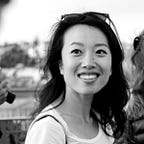“Our country is very peaceful, no?”
I never thought that I would think: “Oh thank goodness we’re back in Pyongyang!” And yet, after only 2 nights away, I was thrilled to be back at Yanggakdo, where the electricity mostly stayed on, and the beds had some semblance of a mattress.
The day started off benignly enough, with a trip through the PY metro station where we had a chance to “ride with locals” who we were promised were not actors. I wanted to be skeptical and stared pretty long and hard at two women who seemed to be pressing one button continuously on their cellphones while sitting next to one another, but after closer observation, they were reading e-books of some kind.
Otherwise, the metro ride was fairly nonchalant, interspersed with adorable children in light-up shoes or very fashionable coats. Oh, and if you haven’t heard yet, the metro is extremely deep underground. In spite of the fact our guides insisted that was just to get underneath the apartments’ foundations, we saw 3 sets of 3-foot deep metal doors just near the bottom entrances that could only have been blast doors.
He said: “Our country is very peaceful, no?” I smiled and told him that the people were very nice.
After the metro ride, we had a chance to tour the People’s Great Hall, a combination of library and lecture rooms that cost nearly $1Bn to build. Where the DPRK gets all this money and why they spend it on absurdly grand edifices is beyond me. At one point we stepped into a “language study room” and chatted with an architecture engineer who was studying English. He asked me what I liked best about his country, to which I replied “it’s scenery and friendly people.”
He said: “Our country is very peaceful, no?” I smiled and told him that the people were very nice.
And in every sense of the word, Koreans are very nice. But when we visited the “Victory museum” and were paraded through rows of captured and shot-down weapons, vehicles, aircraft, etc. I couldn’t help but feel humiliated and embarrassed and ridiculed.
Not because I felt like our military’s actions and involvement during the war was unjustified, but because they showed extremely graphic images of captured or wounded American soldiers. It was like in order to strengthen their perception of victory, they needed to dehumanize and disrespect the other side.
That walk-through was just the beginning, however, as we boarded and toured the USS Pueblo and were forced to sit through an absurd video of how the “US imperialists” were brought to their knees in humiliation and had to admit guilt and formally apologize to the great Korean forces in order to secure the release of the 83 men of the Pueblo. In no less than 5 different occasions were we told that the Korean ship that boarded and captured the Pueblo only had 7 sailors. The great ratio, it was suggested, was owed to then-Marshall Kim Il Sung’s greatness.
The most uncomfortable and ridiculous of all was this ostentatious new Korean War Museum which boasted a 2 story-high plaster statue of Kim Il Sung with fireworks erupting in the background (no photography allowed in the museum). In this museum, we were forced to sit through yet another absurdly voiced-over video title “Who really provoked the Korean War?”.
As the title would suggest, North Koreans believed that it was the US who decided that the Korean peninsula was of critical military and political importance and therefore goaded the South Korean “puppet administration” to declare war on the otherwise peaceful Northern Korea. And even though the surprise attack on April 25th interrupted the gentile, loving and carefree lives of North Korean citizens, the People’s army was able to (all on its own) push back the South Korean forces all the way back to Seoul, where the city was finally “liberated”. Victory, as our guide told us, was achieved by taking a 2-year-old baby army and defending their country against the Superpower aggressors of 15 countries. When the North finally retreated, we were told it was done in such a way that they got all their troops out of the South since new divisions were deployed to fight the northern front.
1 million Chinese soldiers, they said, joined the fight, but this was only begrudgingly revealed at our questioning. How many soldiers were there in the People’s army of the DPRK? That, we were told, is unknown, but there were 10 divisions.
I think it’s fair to tell a different side of the story — we all have that. But the way in which facts were manipulated, quotes, blatantly taken out of context, questions so shamelessly avoided, language so absurdly dramatized…
Dinner was the first saving grace of the day, with a meal at the local Italian restaurant where we had fairly good pizza and some fairly disgusting red wine. The fact that we were even drinking Italian wine in the DPRK was pretty shocking.
Read about the impromptu ski trip we took yesterday, or read on for tomorrow.
This post was written in March 2014 as part of a week-long trip to the DPRK, arranged by the North Korean study group at the Harvard Kennedy School.
